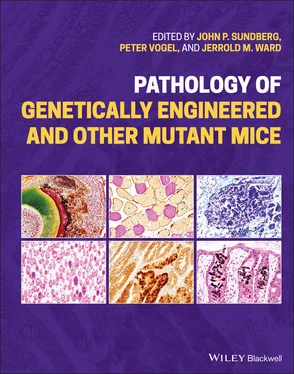Pathology of Genetically Engineered and Other Mutant Mice
Здесь есть возможность читать онлайн «Pathology of Genetically Engineered and Other Mutant Mice» — ознакомительный отрывок электронной книги совершенно бесплатно, а после прочтения отрывка купить полную версию. В некоторых случаях можно слушать аудио, скачать через торрент в формате fb2 и присутствует краткое содержание. Жанр: unrecognised, на английском языке. Описание произведения, (предисловие) а так же отзывы посетителей доступны на портале библиотеки ЛибКат.
- Название:Pathology of Genetically Engineered and Other Mutant Mice
- Автор:
- Жанр:
- Год:неизвестен
- ISBN:нет данных
- Рейтинг книги:3 / 5. Голосов: 1
-
Избранное:Добавить в избранное
- Отзывы:
-
Ваша оценка:
- 60
- 1
- 2
- 3
- 4
- 5
Pathology of Genetically Engineered and Other Mutant Mice: краткое содержание, описание и аннотация
Предлагаем к чтению аннотацию, описание, краткое содержание или предисловие (зависит от того, что написал сам автор книги «Pathology of Genetically Engineered and Other Mutant Mice»). Если вы не нашли необходимую информацию о книге — напишите в комментариях, мы постараемся отыскать её.
An updated and comprehensive reference to pathology in every organ system in genetically modified mice Pathology of Genetically Engineered and Other Mutant Mice
Pathology of Genetically Engineered and Other Mutant Mice
Pathology of Genetically Engineered and Other Mutant Mice — читать онлайн ознакомительный отрывок
Ниже представлен текст книги, разбитый по страницам. Система сохранения места последней прочитанной страницы, позволяет с удобством читать онлайн бесплатно книгу «Pathology of Genetically Engineered and Other Mutant Mice», без необходимости каждый раз заново искать на чём Вы остановились. Поставьте закладку, и сможете в любой момент перейти на страницу, на которой закончили чтение.
Интервал:
Закладка:
20 20 Penner, J.D. and Prieur, D.J. (1987). A comparative study of the lesions in cultured fibroblasts of humans and four species of animals with Chediak‐Higashi syndrome. Am. J. Med. Genet. 28 (2): 445–454.
21 21 Penner, J.D. and Prieur, D.J. (1987). Interspecific genetic complementation analysis with fibroblasts from humans and four species of animals with Chediak‐Higashi syndrome. Am. J. Med. Genet. 28 (2): 455–470.
22 22 Schofield, P.N., Vogel, P., Gkoutos, G.V., and Sundberg, J.P. (2012). Exploring the elephant: histopathology in high‐throughput phenotyping of mutant mice. Dis. Models Mech. 5 (1): 19–25.
23 23 Mezick, J.A., Bhatia, M.C., and Capetola, R.J. (1984). Topical and systemic effects of retinoids on horn‐filled utriculus size in the rhino mouse. A model to quantify “antikeratinizing” effects of retinoids. J. Invest. Dermatol. 83 (2): 110–113.
24 24 Ashton, R.E., Connor, M.J., and Lowe, N.J. (1984). Histologic changes in the skin of the rhino mouse (Hrrh/Hrrh) induced by retinoids. J. Invest. Dermatol. 82 (6): 632–635.
25 25 Bryce, G.F., Bogdan, N.J., and Brown, C.C. (1988). Retinoic acids promote the repair of the dermal damage and the effacement of wrinkles in the UVB‐irradiated hairless mouse. J. Invest. Dermatol. 91 (2): 175–180.
26 26 Kligman, L.H. (1989). Prevention and repair of photoaging: sunscreens and retinoids. Cutis 43 (5): 458–465.
27 27 Sundberg, J.P., Dunstan, R.W., and Compton, J.G. (1989). Hairless mouse, HRS/J hr/hr. In: Integument and Mammary Glands Monographs on Pathology of Laboratory Animals (eds. T.C. Jones, U. Mohr and R.D. Hunt), 192–197. Heidelberg: Springer‐Verlag.
28 28 Sundberg, J.P., Price, V.H., and King, L.E. Jr. (1999). The “hairless” gene in mouse and man. Arch. Dermatol. 135 (6): 718–720.
29 29 Ahmad, W., Faiyaz ul Haque, M., Brancolini, V. et al. (1998). Alopecia universalis associated with a mutation in the human hairless gene. Science 279 (5351): 720–724.
30 30 Ahmad, W., Irvine, A.D., Lam, H. et al. (1998). A missense mutation in the zinc‐finger domain of the human hairless gene underlies congenital atrichia in a family of Irish travellers. Am. J. Hum. Genet. 63 (4): 984–991.
31 31 Ahmad, W., Panteleyev, A.A., Henson‐Apollonio, V. et al. (1998). Molecular basis of a novel rhino (hrrhChr) phenotype: a nonsense mutation in the mouse hairless gene. Exp. Dermatol. 7 (5): 298–301.
32 32 Ahmad, W., Panteleyev, A.A., Sundberg, J.P., and Christiano, A.M. (1998). Molecular basis for the rhino (Hrrh‐8J) phenotype: a nonsense mutation in the mouse hairless gene. Genomics 53 (3): 383–386.
33 33 Panteleyev, A.A., Ahmad, W., Malashenko, A.M. et al. (1998). Molecular basis for the rhino Yurlovo (hr(rhY)) phenotype: severe skin abnormalities and female reproductive defects associated with an insertion in the hairless gene. Exp. Dermatol. 7 (5): 281–288.
34 34 Panteleyev, A.A., Paus, R., Ahmad, W. et al. (1998). Molecular and functional aspects of the hairless (Hr) gene in laboratory rodents and humans. Exp. Dermatol. 7 (5): 249–267.
35 35 Tuttle, A.H., Philip, V.M., Chesler, E.J., and Mogil, J.S. (2018). Comparing phenotypic variation between inbred and outbred mice. Nat. Methods 15 (12): 994–996.
36 36 McElwee, K.J., Niiyama, S., Freyschmidt‐Paul, P. et al. (2003). Dietary soy oil content and soy‐derived phytoestrogen genistein increase resistance to alopecia areata onset in C3H/HeJ mice. Exp. Dermatol. 12 (1): 30–36.
37 37 Ward, J.M. and Devor‐Henneman, D.E. (2004). Mouse models of human familial cancer syndromes. Toxicol. Pathol. 32 (Suppl 1): 90–98.
38 38 Kuperwasser, C., Hurlbut, G.D., Kittrell, F.S. et al. (2000). Development of spontaneous mammary tumors in BALB/c p53 heterozygous mice. A model for Li‐Fraumeni syndrome. Am. J. Pathol. 157 (6): 2151–2159.
39 39 Sundberg, J.P. and Schofield, P.N. (2018). Living inside the box: environmental effects on mouse models of human disease. Dis. Models Mech. 11 (10): dmm035360. https://doi.org/10.1242/dmm.035360.
40 40 Sofaer, J.A. (1969). Aspects of the tabby‐crinkled‐downless syndrome. II. Observations on the reaction to changes of genetic background. J. Embryol. Exp. Morphol. 22 (2): 207–227.
41 41 Sofaer, J.A. (1969). Aspects of the tabby‐crinkled‐downless syndrome. I. The development of tabby teeth. J. Embryol. Exp. Morphol. 22 (2): 181–205.
42 42 Li, Q., Philip, V.M., Stearns, T.M. et al. (2019). Quantitative trait locus and integrative genomics revealed candidate modifier genes for ectopic mineralization in mouse models of pseudoxanthoma elasticum. J. Invest. Dermatol. 139 (12): 2447–2457.e7.
43 43 Montagutelli, X., Hogan, M.E., Aubin, G. et al. (1996). Lanceolate hair (lah): a recessive mouse mutation with alopecia and abnormal hair. J. Invest. Dermatol. 107 (1): 20–25.
44 44 Sundberg, J.P., Boggess, D., Bascom, C. et al. (2000). Lanceolate hair‐J (lahJ): a mouse model for human hair disorders. Exp. Dermatol. 9 (3): 206–218.
45 45 Chavanas, S., Bodemer, C., Rochat, A. et al. (2000). Mutations in SPINK5, encoding a serine protease inhibitor, cause Netherton syndrome. Nat. Genet. 25 (2): 141–142.
46 46 Kljuic, A., Bazzi, H., Sundberg, J.P. et al. (2003). Desmoglein 4 in hair follicle differentiation and epidermal adhesion: evidence from inherited hypotrichosis and acquired pemphigus vulgaris. Cell 113 (2): 249–260.
47 47 Price, V.H., Odom, R.B., Ward, W.H., and Jones, F.T. (1980). Trichothiodystrophy: sulfur‐deficient brittle hair as a marker for a neuroectodermal symptom complex. Arch. Dermatol. 116 (12): 1375–1384.
48 48 Gummer, C.L., Dawber, R.P., and Price, V.H. (1984). Trichothiodystrophy: an electron‐histochemical study of the hair shaft. Br. J. Dermatol. 110 (4): 439–449.
49 49 Metze, D. and Oji, V. (2020). Disorders of keratinization. In: McKee's Pathology of the Skin. 1., 5e (eds. E. Calonje, T. Brenn, A. Lazar and S.D. Billings), 53–117. China: Elsevier.
50 50 Mecklenburg, L., Paus, R., Halata, Z. et al. (2004). FOXN1 is critical for onycholemmal terminal differentiation in nude (Foxn1) mice. J. Invest. Dermatol. 123 (6): 1001–1011.
51 51 Davisson, M.T., Bergstrom, D.E., Reinholdt, L.G., and Donahue, L.R. (2012). Discovery genetics – the history and future of spontaneous mutation research. Curr. Protoc. Mouse Biol. 2: 103–118.
52 52 Probst, F.J. and Justice, M.J. (2010). Mouse mutagenesis with the chemical supermutagen ENU. Methods Enzymol. 477: 297–312.
53 53 Arnold, C.N., Barnes, M.J., Berger, M. et al. (2012). ENU‐induced phenovariance in mice: inferences from 587 mutations. BMC Res. Notes 5: 577.
54 54 Sabrautzki, S., Rubio‐Aliaga, I., Hans, W. et al. (2012). New mouse models for metabolic bone diseases generated by genome‐wide ENU mutagenesis. Mamm. Genome 23 (7‐8): 416–430.
55 55 Potter, P.K., Bowl, M.R., Jeyarajan, P. et al. (2016). Novel gene function revealed by mouse mutagenesis screens for models of age‐related disease. Nat. Commun. 7: 12444.
56 56 Wang, T., Bu, C.H., Hildebrand, S. et al. (2018). Probability of phenotypically detectable protein damage by ENU‐induced mutations in the Mutagenetix database. Nat. Commun. 9 (1): 441.
57 57 Fairfield, H., Srivastava, A., Ananda, G. et al. (2015). Exome sequencing reveals pathogenic mutations in 91 strains of mice with Mendelian disorders. Genome Res. 25 (7): 948–957.
58 58 Palmer, K., Fairfield, H., Borgeia, S. et al. (2016). Discovery and characterization of spontaneous mouse models of craniofacial dysmorphology. Dev. Biol. 415 (2): 216–227.
59 59 Andrews, T.D., Whittle, B., Field, M.A. et al. (2012). Massively parallel sequencing of the mouse exome to accurately identify rare, induced mutations: an immediate source for thousands of new mouse models. Open Biol. 2 (5): 120061. https://doi.org/10.1098/rsob.120061.
Читать дальшеИнтервал:
Закладка:
Похожие книги на «Pathology of Genetically Engineered and Other Mutant Mice»
Представляем Вашему вниманию похожие книги на «Pathology of Genetically Engineered and Other Mutant Mice» списком для выбора. Мы отобрали схожую по названию и смыслу литературу в надежде предоставить читателям больше вариантов отыскать новые, интересные, ещё непрочитанные произведения.
Обсуждение, отзывы о книге «Pathology of Genetically Engineered and Other Mutant Mice» и просто собственные мнения читателей. Оставьте ваши комментарии, напишите, что Вы думаете о произведении, его смысле или главных героях. Укажите что конкретно понравилось, а что нет, и почему Вы так считаете.












